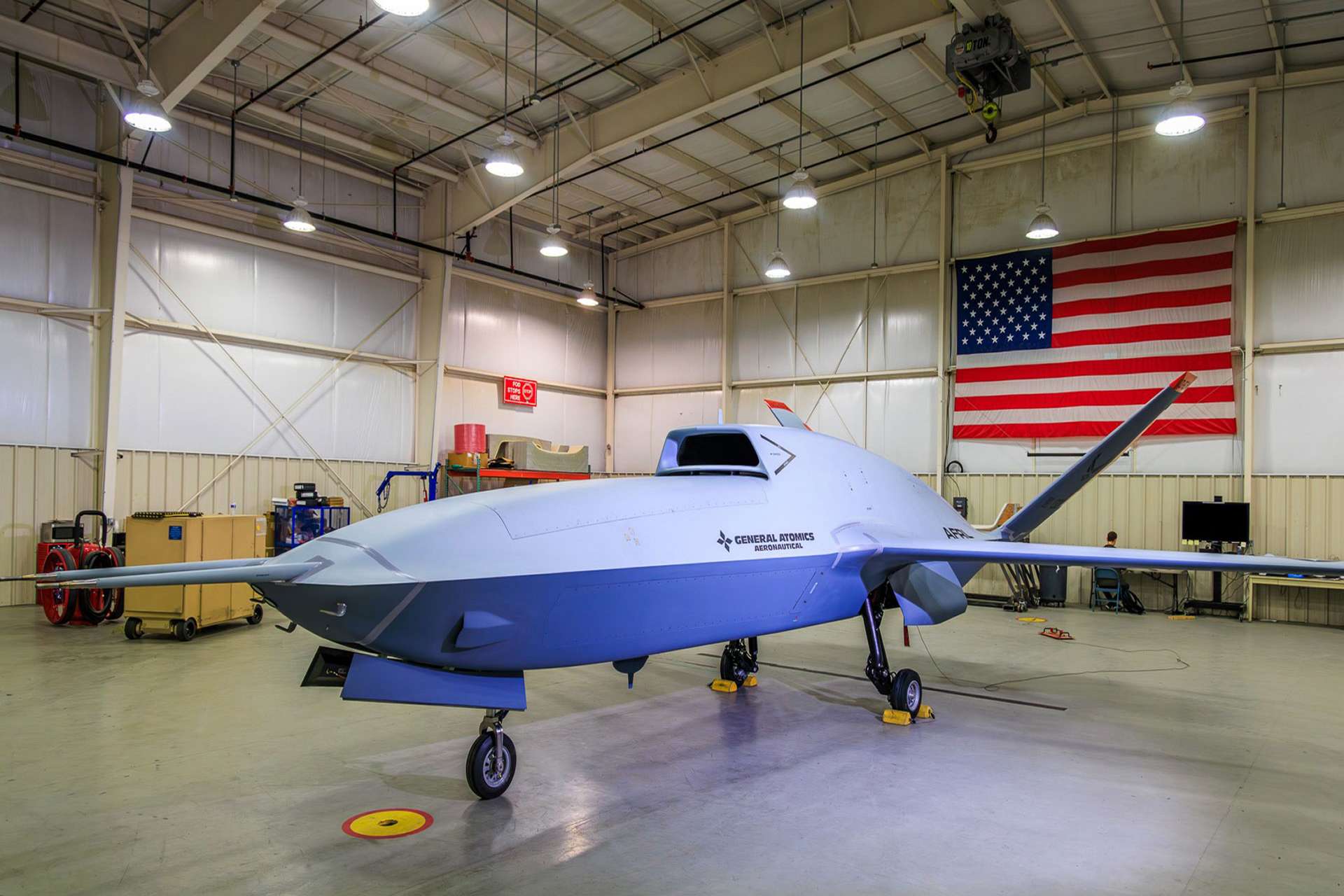USAF Research Lab Invests in XQ-67A Next-Gen Combat Drone by General Atomics

{loadposition bannertop}
{loadposition sidebarpub}
On July 2, 2024, General Atomics received an additional $9 million from the US Air Force Research Laboratory (AFRL) to continue the development of the XQ-67A, an experimental Off-Board Sensing Station (OBSS) jet. This funding is part of AFRL’s Low-Cost Attritable Aircraft Platform Sharing (LCAAPS) program, aiming to enhance data-sharing capabilities on autonomous drones.Follow Army Recognition on Google News at this link
General Atomics XQ-67A Next-Gen Combat Drone (Picture source: General Atomics)
The XQ-67A, capable of both remote piloting and autonomous flight, is considered a cornerstone in General Atomics’ bid for an autonomous aircraft capable of supporting crewed fighters. This initiative builds on the legacy of Kratos’ XQ-58A Valkyrie, developed under the USAF’s Skyborg program and currently being tested by the US Marine Corps.
Since its first flight on February 28, 2024, the XQ-67A has successfully completed three test flights. General Atomics emphasized that the aircraft is a preliminary version of a Collaborative Combat Aircraft (CCA), with plans to develop multiple variants from a common core chassis. These successful test flights mark a significant milestone, paving the way for a comprehensive production and flight test program.
The Air Force is also exploring other autonomous technologies, notably through the X-62 VISTA, a modified F-16 aircraft. Last month, Secretary of the Air Force Frank Kendall participated in simulated dogfights aboard an AI-piloted VISTA against a human pilot, highlighting advancements in autonomous capabilities.
The AFRL’s XQ-67A, designed and developed in just over two years, complements efforts with the X-62 VISTA and F-16 VENOM to expedite the deployment of CCAs. Air Force leaders are committed to integrating these advancements alongside traditional aircraft programs. In May, Chief of Staff of the Air Force, General David W. Allvin, outlined a strategy for concurrent development processes, merging platform development with doctrine, organization, training, leadership, education, personnel, and facilities.
At an AFA Warfighters in Action event, General Allvin reiterated the importance of human-machine collaboration and the potential for rapid adoption and discarding of CCA technologies, contrasting with the prolonged development cycles of traditional aircraft programs.
Equipped with advanced sensor systems, the XQ-67A can collect and transmit real-time data, enhancing coordination with other autonomous and manned units. This capability is crucial for modern combat missions, where timely and accurate information is essential. The LCAAPS program aims not only to reduce drone production costs but also to enable large-scale deployment, creating a more flexible and resilient air force.
Attritable drones like the XQ-67A are designed for high-risk environments where losses are anticipated, providing a cost-effective solution to maintain air superiority without risking pilot lives. The broader strategy includes integrating artificial intelligence and machine learning for autonomous piloting, target recognition, and real-time decision-making on the battlefield.
The development of the XQ-67A and similar drones represents a significant step towards the future of surveillance, reconnaissance, and combat missions. Their ability to operate autonomously, communicate with other units, and adapt to changing conditions makes them invaluable.
The AFRL initiative reflects a global trend towards integrating robotics and autonomy in military operations, potentially transforming future conflicts by enhancing efficiency and reducing risks for soldiers. With these advancements, the US Air Force positions itself at the forefront of military technological innovation, paving the way for a new era of autonomous and collaborative warfare.
As a reminder, the Air Force Research Laboratory is the primary scientific research and development center for the Department of the Air Force. AFRL plays an integral role in leading the discovery, development, and integration of affordable warfighting technologies for our air, space, and cyberspace force.

{loadposition bannertop}
{loadposition sidebarpub}
On July 2, 2024, General Atomics received an additional $9 million from the US Air Force Research Laboratory (AFRL) to continue the development of the XQ-67A, an experimental Off-Board Sensing Station (OBSS) jet. This funding is part of AFRL’s Low-Cost Attritable Aircraft Platform Sharing (LCAAPS) program, aiming to enhance data-sharing capabilities on autonomous drones.
Follow Army Recognition on Google News at this link
General Atomics XQ-67A Next-Gen Combat Drone (Picture source: General Atomics)
The XQ-67A, capable of both remote piloting and autonomous flight, is considered a cornerstone in General Atomics’ bid for an autonomous aircraft capable of supporting crewed fighters. This initiative builds on the legacy of Kratos’ XQ-58A Valkyrie, developed under the USAF’s Skyborg program and currently being tested by the US Marine Corps.
Since its first flight on February 28, 2024, the XQ-67A has successfully completed three test flights. General Atomics emphasized that the aircraft is a preliminary version of a Collaborative Combat Aircraft (CCA), with plans to develop multiple variants from a common core chassis. These successful test flights mark a significant milestone, paving the way for a comprehensive production and flight test program.
The Air Force is also exploring other autonomous technologies, notably through the X-62 VISTA, a modified F-16 aircraft. Last month, Secretary of the Air Force Frank Kendall participated in simulated dogfights aboard an AI-piloted VISTA against a human pilot, highlighting advancements in autonomous capabilities.
The AFRL’s XQ-67A, designed and developed in just over two years, complements efforts with the X-62 VISTA and F-16 VENOM to expedite the deployment of CCAs. Air Force leaders are committed to integrating these advancements alongside traditional aircraft programs. In May, Chief of Staff of the Air Force, General David W. Allvin, outlined a strategy for concurrent development processes, merging platform development with doctrine, organization, training, leadership, education, personnel, and facilities.
At an AFA Warfighters in Action event, General Allvin reiterated the importance of human-machine collaboration and the potential for rapid adoption and discarding of CCA technologies, contrasting with the prolonged development cycles of traditional aircraft programs.
Equipped with advanced sensor systems, the XQ-67A can collect and transmit real-time data, enhancing coordination with other autonomous and manned units. This capability is crucial for modern combat missions, where timely and accurate information is essential. The LCAAPS program aims not only to reduce drone production costs but also to enable large-scale deployment, creating a more flexible and resilient air force.
Attritable drones like the XQ-67A are designed for high-risk environments where losses are anticipated, providing a cost-effective solution to maintain air superiority without risking pilot lives. The broader strategy includes integrating artificial intelligence and machine learning for autonomous piloting, target recognition, and real-time decision-making on the battlefield.
The development of the XQ-67A and similar drones represents a significant step towards the future of surveillance, reconnaissance, and combat missions. Their ability to operate autonomously, communicate with other units, and adapt to changing conditions makes them invaluable.
The AFRL initiative reflects a global trend towards integrating robotics and autonomy in military operations, potentially transforming future conflicts by enhancing efficiency and reducing risks for soldiers. With these advancements, the US Air Force positions itself at the forefront of military technological innovation, paving the way for a new era of autonomous and collaborative warfare.
As a reminder, the Air Force Research Laboratory is the primary scientific research and development center for the Department of the Air Force. AFRL plays an integral role in leading the discovery, development, and integration of affordable warfighting technologies for our air, space, and cyberspace force.





